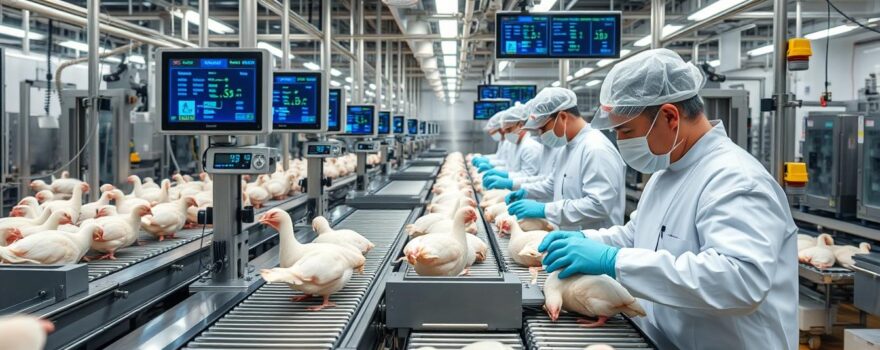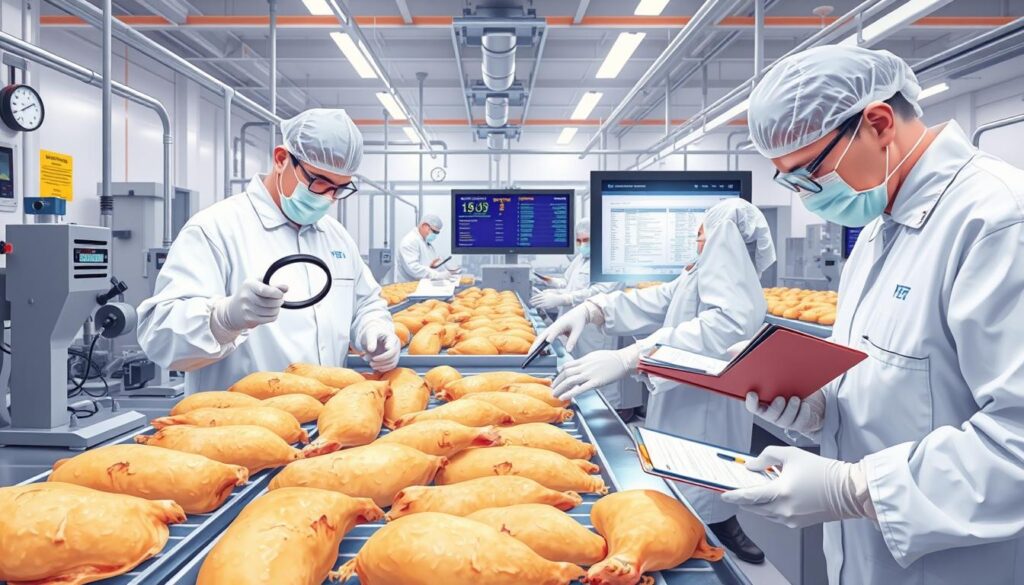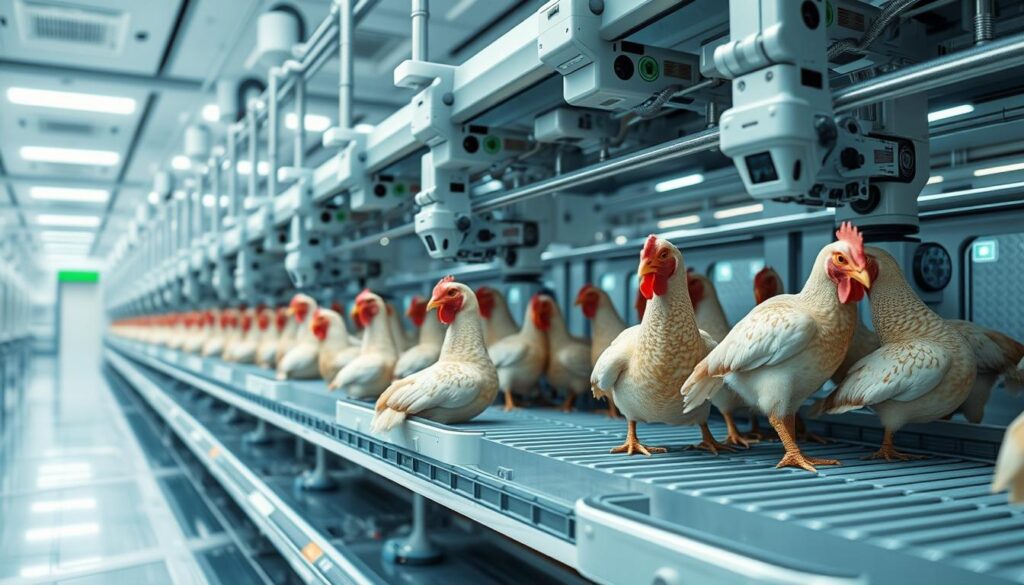
Quality control in broiler chicken processing is all about making sure chicken products are safe and consistent. It involves many steps to prevent contamination and ensure quality. The main goals are to stop contamination, keep product quality the same, and find and handle risks.
It also means watching how chicken is processed, keeping track of everything, testing products, and always trying to get better. Having a good quality control system is key to making chicken products that are safe and meet customer needs.
The Food Safety and Inspection Service (FSIS) checks on quality control in meat and poultry. They make sure products are safe for sale. Companies that make meat and poultry for sale have to follow HACCP guidelines to keep food safe.
Key Takeaways
- Quality control in broiler chicken processing ensures product safety, consistency, and quality throughout the production process.
- FSIS oversees quality control checks and HACCP guidelines for meat and poultry products intended for commercial distribution.
- Effective quality control measures involve identifying and managing potential hazards, monitoring processing parameters, and maintaining detailed documentation.
- Implementing a robust quality control system is crucial for delivering safe and high-quality chicken products that meet consumer expectations.
- Continuous improvement and adherence to industry best practices are essential for maintaining a strong quality control program in broiler chicken processing.
What is Quality Control in Broiler Chicken Processing?
Quality control in broiler chicken processing is all about making sure chicken products are safe and consistent. It involves many steps to keep the quality high from start to finish. The main goals are to stop contamination, make sure products are the same, find and handle risks, check how things are made, keep track of everything, test products, and always get better.
Understanding the Importance of Quality Control Measures
Quality control is key in the meat and poultry world. It helps keep food safe, makes sure products are the same, and makes customers trust the brand. By using strict quality control, companies can lower risks, follow rules better, and give customers what they want.
Ensuring Food Safety, Consistency, and Consumer Confidence
Quality control in broiler chicken processing includes many steps:
- Stopping contamination by keeping things clean and controlling temperatures
- Always checking how things are made to keep quality up
- Finding and managing risks with detailed plans
- Keeping records and tracking things to follow rules and be accountable
- Testing products often to make sure quality control works
By following these steps, companies can make sure their chicken is safe, consistent, and trusted by customers. This helps them succeed and grow in the long run.
Stages of Quality Control Checks in Broiler Chicken Processing
Ensuring high-quality broiler chicken products is a detailed process. It involves thorough quality control at every stage. The first step is a detailed hazard analysis. This helps identify potential risks to food safety and product quality.
Hazard Analysis and Identification
Producers analyze the production process to find areas of concern. They then use risk mitigation strategies to address these issues. Factors like transportation, stunning, and scalding are key to the final product’s quality.
Establishing Critical Control Points (CCPs)
After the hazard analysis, producers set up critical control points (CCPs) in the HACCP system. These points are where control can be applied to reduce hazards to safe levels.
| Key Quality Control Stages | Potential Hazards | Critical Control Points |
|---|---|---|
| Transportation | Bruising, contamination | Minimize transport duration, control stocking density |
| Stunning | Improper bleeding, meat quality issues | Maintain appropriate electrical parameters, monitor bleed time |
| Scalding | Carcass discoloration, inconsistent feather removal | Ensure uniform temperature, monitor scald time |
By setting up these critical control points, producers can monitor and verify their quality control measures. This ensures the safety and consistency of their broiler chicken products.
Setting Critical Limits and Monitoring CCPs
First, we identify the Critical Control Points (CCPs) in broiler chicken processing. Then, we set critical limits for each CCP. These limits are the max or min values for chemical, biological, or physical parameters. They ensure food safety and quality.
When setting critical limits, we consider a few things:
- Thermal processing: Cooking meat to 165°F is key to kill Salmonella.
- Cold storage: Keeping chiller and freezer temperatures at 40°F and 0°F stops pathogen growth.
- Hot holding: Foods must stay between 40°F and 140°F for 2-4 hours to prevent growth.
- Cooling: Cooked products need to cool to 70°F in 2 hours to stop pathogens.
- Product formulation: Adding vinegar or citric acid can help stop microbial growth.
Monitoring these limits is key to keep the process under control and quality consistent. This can be done through continuous monitoring, testing, or visual checks. Keeping detailed records is also important to show the quality control system works.
| Critical Control Point | Critical Limit | Monitoring Procedure |
|---|---|---|
| Cooking | Minimum internal temperature of 165°F for poultry | Continuous temperature monitoring using calibrated thermometers |
| Cold Storage | Chiller temperature ≤40°F, Freezer temperature ≤0°F | Periodic temperature checks using calibrated thermometers |
| Hot Holding | Time in danger zone (40-140°F) ≤4 hours | Continuous temperature monitoring and time logging |
| Cooling | Cool to 70°F within 2 hours | Periodic temperature checks and time logging |
| Product Formulation | pH ≤4.6 | Periodic pH testing using calibrated meters |
By setting and monitoring these limits, we keep the process under control. This ensures safe, high-quality broiler chicken products.
Corrective Actions and Recordkeeping Procedures
In the world of broiler chicken processing, keeping quality and safety high is key. Even with strong quality control measures, problems can still happen. The HACCP (Hazard Analysis and Critical Control Points) system needs clear corrective actions for these times.
Implementing Corrective Measures
If a problem is found, the quality team must act fast. They might:
- Find out why the problem happened
- Take steps to fix it and keep things within limits
- Make sure any bad product is handled right to keep it from getting to customers
- Check if the fixes worked to stop the problem from happening again
Maintaining Detailed Documentation
Keeping good records is key to the HACCP system. Broiler chicken processors need to keep detailed records of their quality work. This includes:
- Monitoring data – Records of what’s checked at key points
- Corrective actions taken – What was done to fix problems
- Verification and validation activities – Checks to make sure the HACCP plan works
- Product traceability and recall procedures – How to track and pull bad products
By taking strong corrective actions and keeping good records, chicken processors can make sure their products are safe, consistent, and of high quality. This builds trust with consumers.

Verification and Validation Processes
To keep the quality control system in broiler chicken processing effective, regular verification and validation are key. Verification checks if the control measures, like the HACCP system, work as planned and are used right every time.
This step might include independent audits, reviews, and tests to check if the quality control steps are correct and dependable. By making sure the HACCP system and other quality assurance steps are followed well, broiler chicken makers can keep food safe and consistent. This builds trust with consumers.
Validation, however, checks if the control steps in the HACCP system really stop hazards. It looks at data to see if the limits, checks, and fixes are right. This helps prevent or lessen risks in broiler chicken making.
“Regular verification and validation of the quality control system is crucial to ensure the ongoing safety and quality of broiler chicken products.”
By carefully checking and confirming their quality control steps, broiler chicken makers show they care about food safety and quality assurance. This boosts consumer trust and meets rules.
Challenges in Quality Control for the Meat Industry
The broiler chicken processing industry has big challenges for quality control. Meat and poultry products are perishable. The global supply chain is complex, making things harder.
Perishable Nature and Complex Supply Chain
Broiler chickens are very perishable. They have a short shelf life, needing careful temperature control. Keeping the right temperature is key to stop harmful bacteria and keep food safe.
The global supply chain is complex. It has many handlers and ways to transport goods. This makes keeping the right temperature a big challenge.
Microbial Risks and Temperature Control
The meat industry worries about Salmonella and Campylobacter. These bacteria can harm people. Keeping the right temperature is crucial to stop their growth.
Using strong monitoring systems and strict rules is important. This helps keep broiler chicken products safe and of high quality.
To solve these problems, we need new technologies and better data analysis. Understanding the meat industry’s unique challenges is key. This way, we can improve quality control and give consumers safe, quality products.
“Identifying genetic causes and associated markers may help chicken breeders to improve muscle development and address meat quality issues in the poultry industry.”
How to Implement Quality Control Measures in Broiler Chicken Processing
Quality control in broiler chicken processing is key for food safety and consumer trust. Facilities should use the Hazard Analysis and Critical Control Points (HACCP) system. HACCP helps identify and control food safety risks.
Integrating HACCP Principles
Adopting HACCP helps poultry plants create a solid quality control plan. This includes several important steps:
- First, do a detailed hazard analysis to find potential risks.
- Then, find the critical control points (CCPs) where these risks can be managed.
- Set limits for each CCP to keep the process safe.
- Keep monitoring and recording to check if controls work.
- Have plans for what to do if something goes wrong.
- Check and update the HACCP system often to keep it working well.
Good Manufacturing Practices and Sanitation Protocols
Poultry plants also need to follow Good Manufacturing Practices (GMPs) and sanitation rules. These steps keep the environment clean and controlled. Important parts include:
- Clean and sanitize everything well.
- Store and handle materials and products right.
- Train employees on safety and quality.
- Monitor and document processes to follow standards.
By using HACCP and following GMPs and sanitation rules, plants can ensure quality and safety. This way, they can provide safe, high-quality chicken to consumers.
Emerging Technologies and Continuous Improvement
The broiler chicken processing industry is always changing. It uses emerging technologies and works on continuous improvement. Automation, data analytics, and new processing methods improve efficiency and quality.
Precision Livestock Farming (PLF) tools collect data on animals and their living conditions. This helps spot animal welfare issues early. It also speeds up management decisions and cuts down on losses.
Robotics are key in the industry. They help with cleaning, egg collection, disease prevention, and monitoring. 3D printing is also used to save time and money by printing parts like prosthetics on-site.
AI-powered processing systems automate tasks like deboning. This boosts productivity and precision. Sensor technologies like those for ammonia, carbon dioxide, and temperature control are also important. They help keep the climate and health in poultry houses right.
These emerging technologies and continuous improvement efforts make the industry more efficient. They help meet the growing demand for poultry products. As the world’s population grows, the poultry industry must keep up and innovate to provide quality chicken.
| Statistic | Value |
|---|---|
| Global chicken meat consumption expected to exceed pork by 2022 | – |
| Feed-to-meat ratio in poultry production | 1.4 kg feed : 1 kg live-weight meat |
| Poultry producers’ target feed-to-meat ratio | 1:1 |
| Egg consumption growth | Increasing due to eggs being inexpensive, mild-tasting, and easy to process |
| Additional population expected in the next 30 years | 3 billion people |
| Poultry meat production in the European Union (2019) | 13.3 million tonnes |
| Poland’s poultry meat production (2019) | 2.6 million tonnes |
| Poland’s share of global poultry meat exports | 9% (1.5 million tonnes) |
The broiler chicken processing industry keeps adopting emerging technologies and focuses on process optimization and data analytics. This is key to meeting the growing demand for poultry products. It ensures food safety and drives continuous improvement in the industry.

Quality control is key in broiler chicken processing. It ensures chicken products are safe, consistent, and top-notch. By using a detailed quality control system, processors can spot and fix problems early.
They can keep their operations in check and always look for ways to get better. This is crucial for keeping food safe and meeting customer needs.
By following HACCP, GMPs, and new tech, chicken processors can make their products better and safer. This builds trust with customers and helps the industry grow.
Quality control is vital for the chicken industry’s success. It keeps the industry’s good name, helps it grow, and gives customers what they want. By always trying to improve, chicken processors can keep food safe and meet customer expectations.